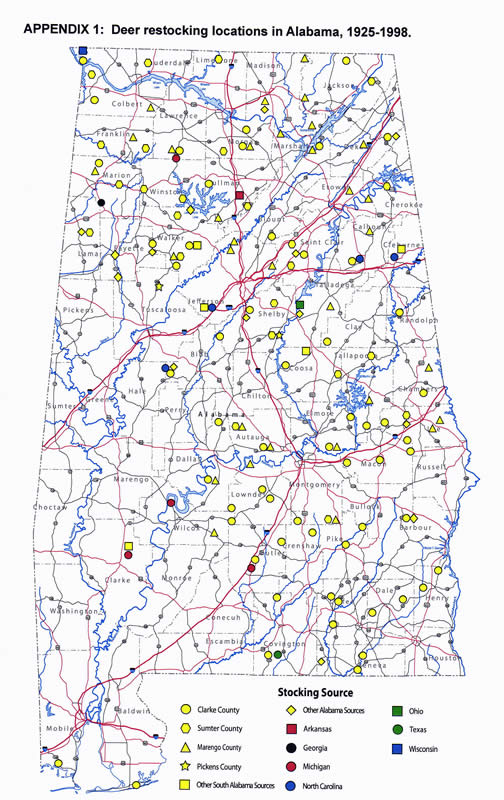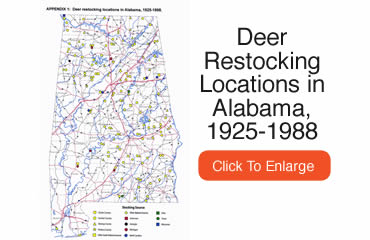In the past, the rut in Alabama has been a mysterious phenomenon. The breeding activity of white-tailed deer in one part of the state doesn’t necessarily coincide with the rutting activity in other parts of the state. As research continues to reveal more information about the rut in Alabama, it certainly doesn’t fit into a category that wildlife biologists would consider typical.
Because Alabama had to undergo an extensive restocking program through much of the middle of the 20th century, the breeding activity for Alabama’s deer is all over the figurative and literal map.
“You can look at the distribution map of where deer were stocked in the 1940s, 50s and 60s, and you can see the different genetics on those deer that came from the different parts of the country and even different parts of the state,” said Chuck Sykes, Alabama Wildlife and Freshwater Fisheries Director. “You can see the differences in the rut. That’s why we’ve been working diligently for the past 10 years to collect fetal data so we can more effectively manage those deer herds like they need to be.
“If you look over on the Chattahoochee River, or say in Russell County, where you’ve got several different pockets of deer that start rutting the first week of November and rut all the way through January.”
 The genetic diversity, which influences breeding behavior, makes it hard for Wildlife and Freshwater Fisheries (WFF) personnel to establish seasons and bag limits that work for the entire state.
The genetic diversity, which influences breeding behavior, makes it hard for Wildlife and Freshwater Fisheries (WFF) personnel to establish seasons and bag limits that work for the entire state.
“It makes our job very difficult biologically because you’ve got some fawns that are being born in June and some being born in September and early October,” Sykes said. “So the seasons need to be a little bit different and be reflective of these differences. You don’t need your bow season coming in October 15 when they’re dropping fawns in September. So it’s a pretty difficult job because of the different deer we have and the different genetics throughout the state.”
Rutting activity for most of the state is based on the genetics mainly from the deer captured in southwest Alabama and relocated to other parts of the state.
“The predominant rut is from the last two weeks of January through the first two weeks of February,” Sykes said. “It’s never going to be 100 percent. You’re going to have some deer that come in a little early and you’re going to have some deer come in a little later.”
The 2014-2015 deer seasons feature a split of the state into two zones with the south zone basically the area south of Montgomery (see map). The south zone swapped 10 days of hunting in December for 10 days of hunting in February.
“That’s why we drew the line like we did — to give the hunters in south Alabama the 10 days in February, because according to the biological data that’s when the rut is happening,” Sykes said. “Once you get north of there, you have isolated pockets that rut like the deer in south Alabama because they were taken from the Stimpson Sanctuary (Clarke County) and places like that. But for the most part, the deer in north Alabama rut more in mid to late December and the first couple of weeks in January.
 “There are several oddball areas. If you look on the map and check the (color-coded) dots, you’ll see where the deer came from. You’ll see deer from Wisconsin or Texas and where they were placed throughout the state.
“There are several oddball areas. If you look on the map and check the (color-coded) dots, you’ll see where the deer came from. You’ll see deer from Wisconsin or Texas and where they were placed throughout the state.
Even though it’s been 50 or 60 years ago, the rut still mirrors the basic genetics of that deer herd. So there are isolated pockets in Alabama, unlike any other place in the nation where I’ve worked, where you’ve got deer rutting in November, December, January and February. You’ve got months that, depending on where you are in the state, you can hunt the rut.
“If I’m managing property in Illinois or Ohio, you’ve got two weeks you can hunt the rut, and then you may have two weeks with a small secondary rut. In Alabama, in some places, you can hunt part of the rut four months out of the year. It’s unlike any other place in the country.”
While most places in the Midwest have a defined, distinctive rutting period, it’s not as easy to determine in Alabama for several reasons.
“That can get back to the age structure of your deer herd or an unbalanced buck-to-doe ratio or hunting pressure,” Sykes said. “Those deer are going to rut, but if you’re pressuring them hard, you’re not going to see them. They’re going to do it at night. Our weather is so crazy, it may be 85 degrees in January and those bucks aren’t comfortable chasing hard in the middle of the day. They’re going to do it at night.
“As far as having a strong, condensed rut, like you see in other places, you’re not going to see it statewide. Now there are isolated places that do have that, places that worked hard to get their buck-to-doe ratio right, get their age structure where they have a lot of older-age bucks. They see the rut and see it well. But statewide, you’re not going to see that hard, intense rut like you see in the Midwest.”
When it comes to hunting, Sykes’ tactics during the rut are pretty simple.
“I’m going to where most of the women are,” he said. “Early season, I’m looking for food. I’m hunting a swamp chestnut oak, where those bucks are concentrated, packing on the fat, getting ready for the rut.
“When it comes January, I’m going where the does are. I’m probably going to be close to a bedding area just in case those bucks don’t want to get up a lot during daylight hours. If I’m close to that area where the does are and where they’re bedding, the better chance I’ve got of seeing him in daylight.”
While most of Alabama’s deer activity occurs during the dim light times of early morning and late afternoon, Sykes’ philosophy is that more time in the stand yields more results.
“You can’t kill him if you’re not in the woods,” he said. “When I hunt in the Midwest, I hunt from daylight to dark. I’ve gotten lazy when I come back home and I hunt an hour or two after daylight and an hour or two before dark. If the weather is right – good and cold — deer are going to move on and off all day. They’re not going to move all day, but they’ll move a little bit and lay down. Then a couple of hours later, he’s going to get up and cruise around again. So, if you’re in the camp, you can’t get him.”
The current season has been a banner year for big bucks in Alabama. Almost every day since the season started, someone has posted a photo of a trophy buck that was taken in various areas around the state.
Sykes, a wildlife management consultant for numerous properties in Alabama and other states before he became WFF Director in 2012, said he has a pretty good idea of why so many big bucks have been taken.
“This is the seventh or eighth year of a buck limit,” he said. “Now that they can only kill three (bucks), people are getting more selective instead of shooting everything that walks by. People are more educated on what it takes to have a quality deer herd, and they’re letting these young bucks walk. Some clubs are even letting the three-year-olds walk. I think the proof is in the pudding, and you’re seeing big bucks falling all over the state. And the weather hasn’t been that great this year.”











































